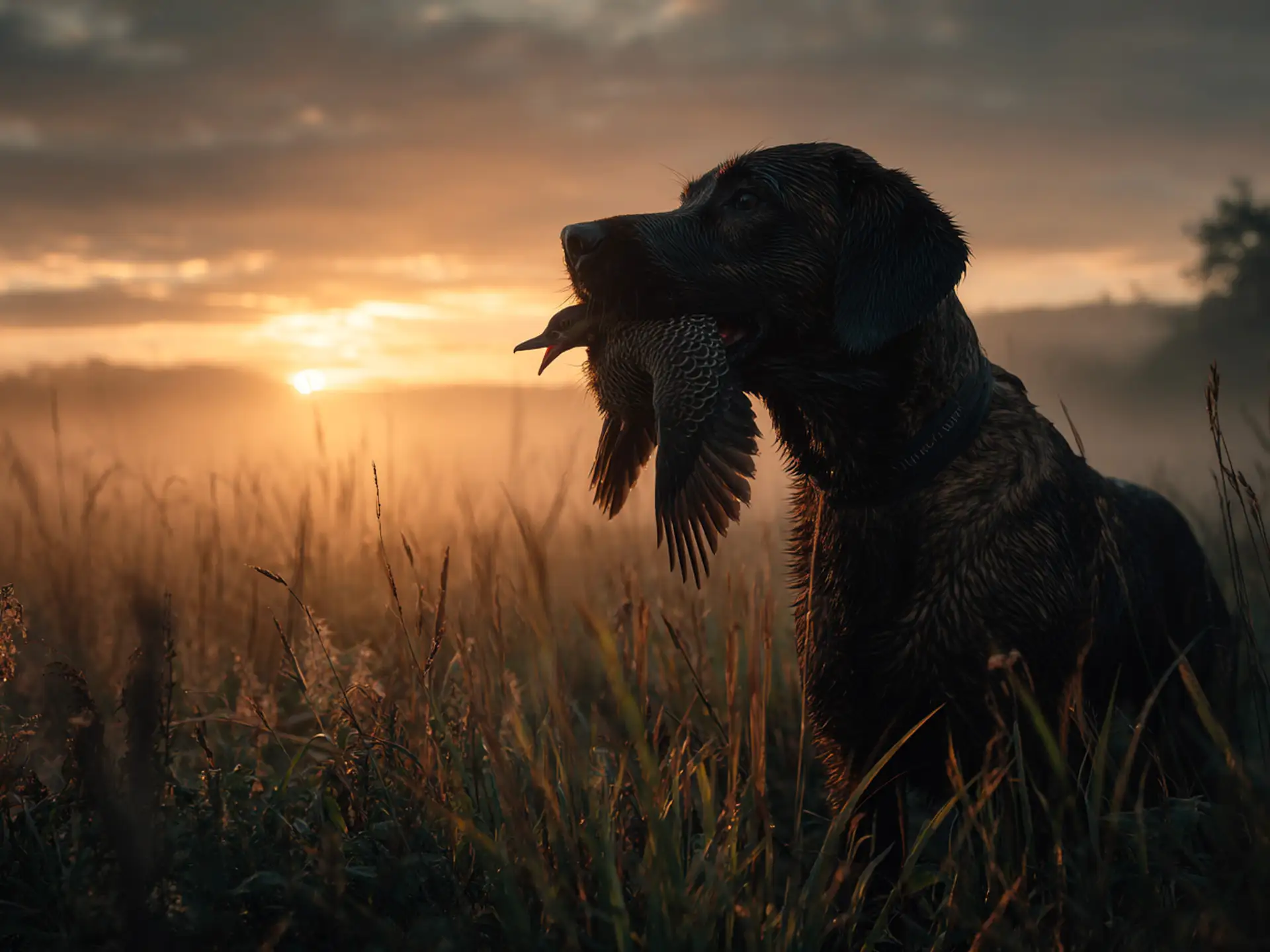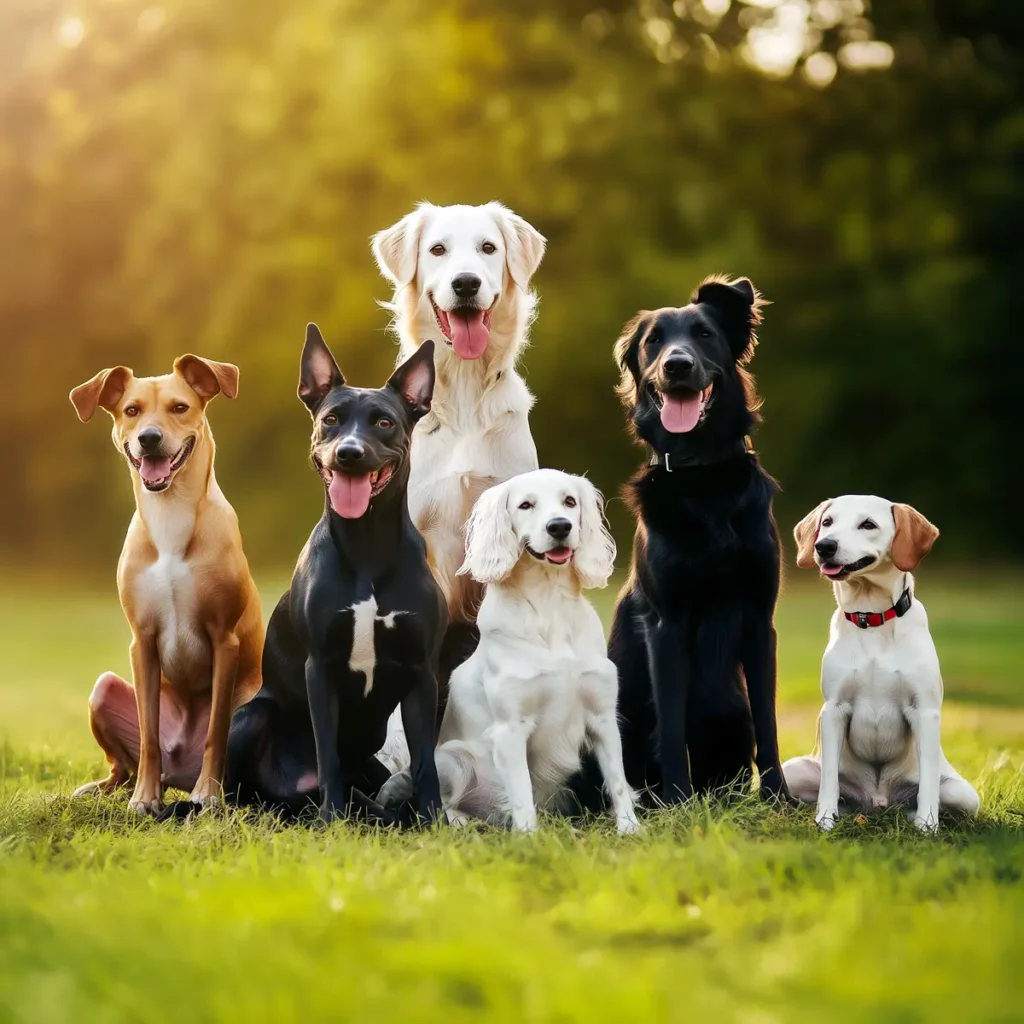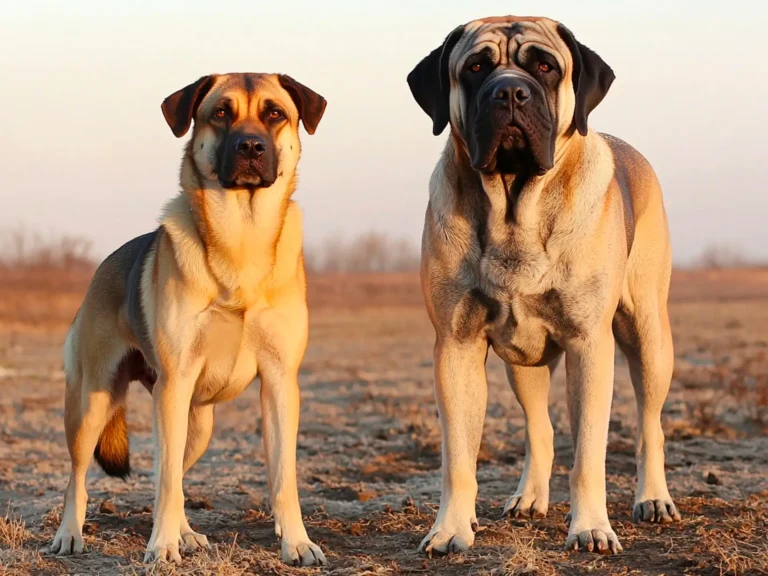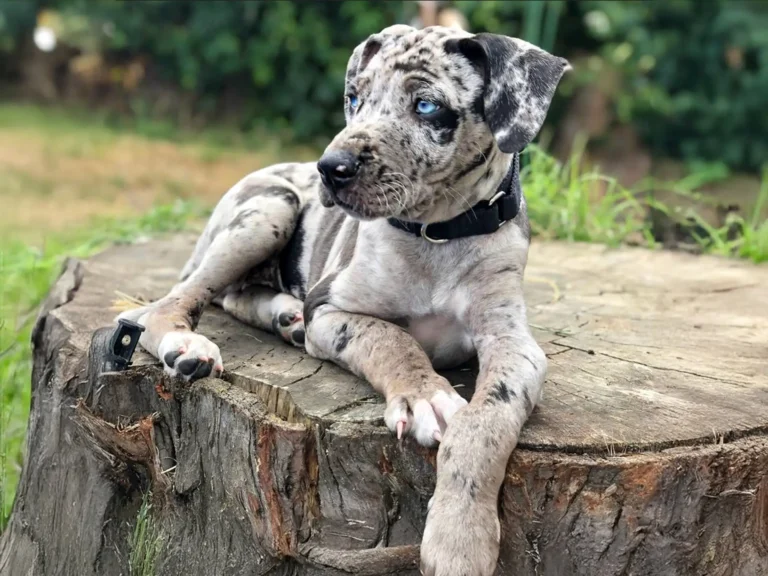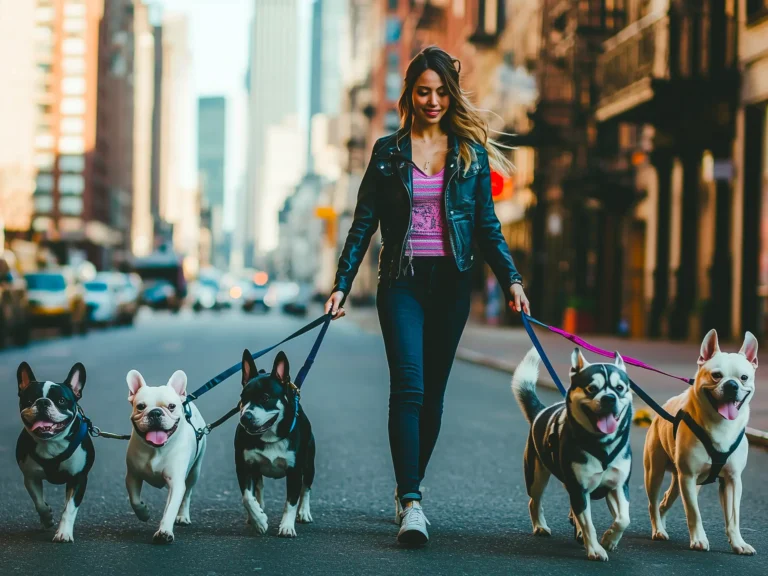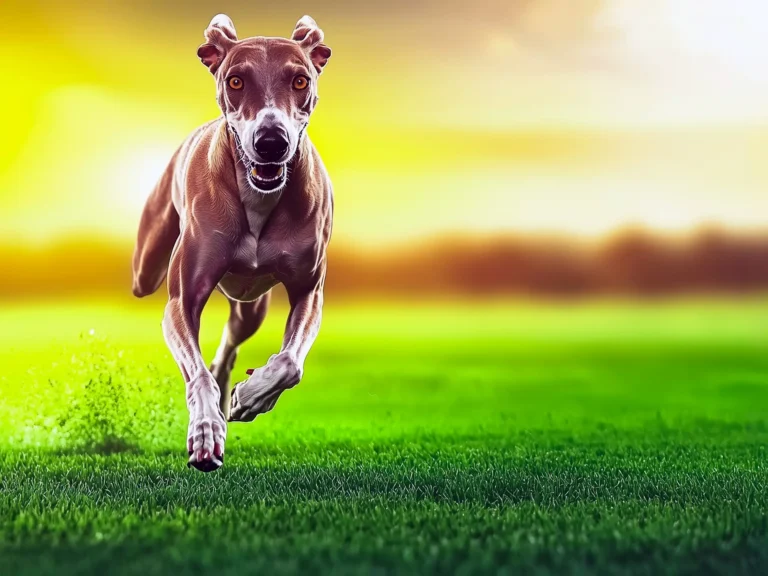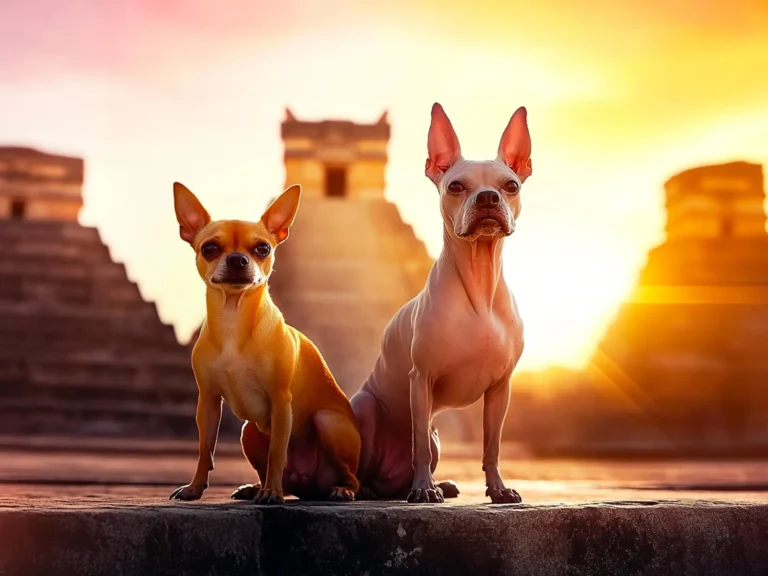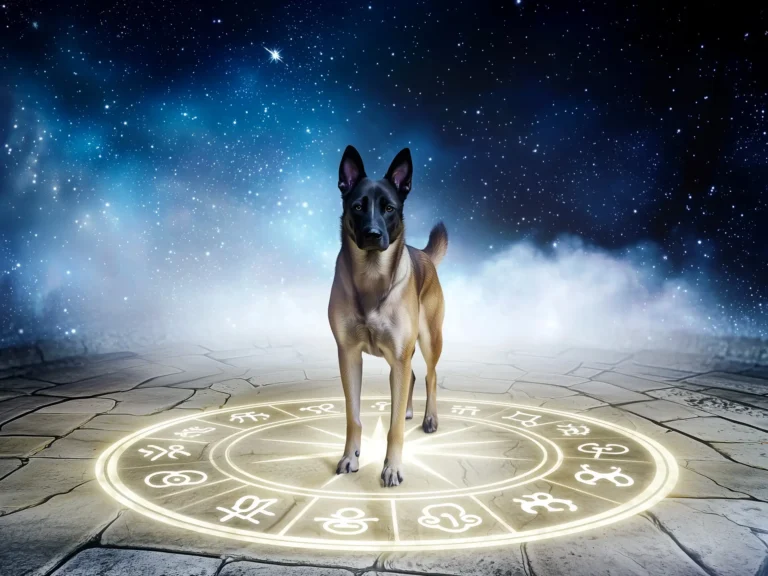There’s a reason German hunting dogs have a legendary reputation among hunters. For centuries, German breeders have focused on creating dogs that can handle real-world challenges: pointing gamebirds with precision, tracking wounded deer across rugged terrain, plunging into icy lakes after waterfowl, or fearlessly flushing foxes from thick cover.
These dogs aren’t just specialists; many are versatile partners that can adapt to almost any hunting scenario.
But choosing the right German hunting dog breed isn’t simple. Each breed comes with its own strengths, energy levels, training needs, and personality quirks. Some make fantastic family companions as long as they get plenty of exercise. Others are born workaholics best suited for hunters who spend long hours in the field.
In this guide, we’ll break down the 12 best German hunting dog breeds with in-depth profiles, comparisons, and practical advice. Whether you’re after a tireless upland bird dog, a loyal big-game tracker, or a water-loving retriever, this article will help you find the perfect partner for both the hunt and home life.
Why German Hunting Dogs Stand Out
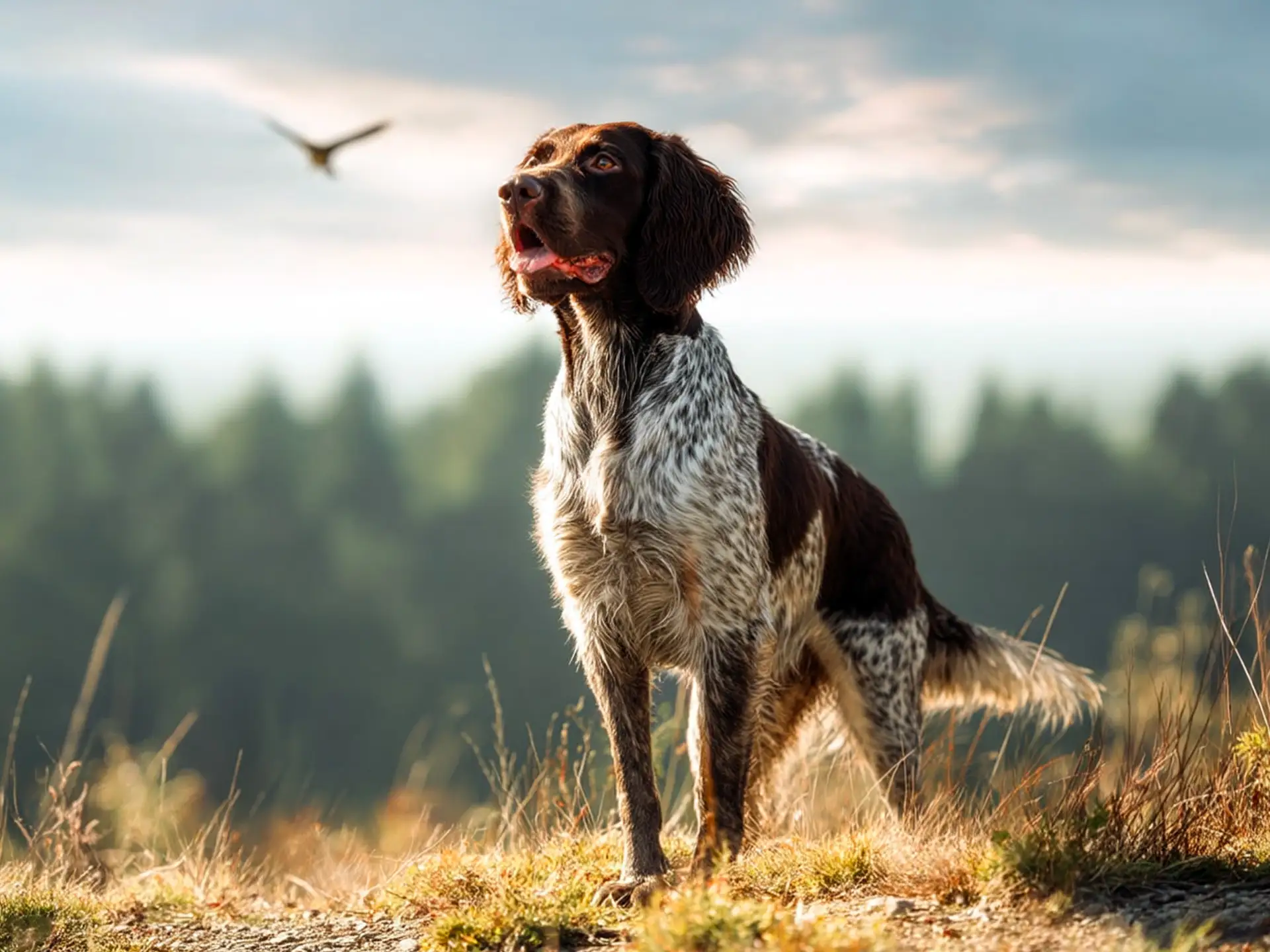
German hunting dog breeds didn’t earn their reputation by accident. For generations, breeders in Germany have followed strict standards to produce dogs that could thrive in real hunting conditions. Performance has always mattered more than appearance, and that philosophy shows in every aspect of these dogs — from their powerful noses to their sharp intelligence and tireless work ethic.
One key factor is Germany’s tradition of field testing and breeding regulations. Many German hunting dogs must pass demanding trials before they are even considered for breeding. These tests measure obedience, pointing skills, tracking ability, and water retrieves. As a result, when you bring home a well-bred German hunting dog, you’re getting a partner whose instincts have been shaped by centuries of purpose-driven selection.
Versatility is another hallmark of these breeds. While some excel in specialized roles like tracking wounded big game, many can handle multiple jobs in a single day — pointing birds at dawn, retrieving ducks at midday, and trailing deer at dusk. This adaptability makes them ideal companions for hunters who want one dog that can do it all.
And when the guns are put away? Most German hunting dogs settle happily into family life, provided they get enough exercise and mental stimulation. Their loyalty, intelligence, and even temperaments mean they can switch from serious hunting partner to affectionate family member with ease — as long as their active minds and bodies stay engaged.
Quick Comparison Table: German Hunting Dog Breeds at a Glance
| Breed Name | Best Hunting Role | Energy Level | Training Difficulty | Family Suitability |
|---|---|---|---|---|
| German Shorthaired Pointer | Upland birds, versatile hunting | Very High | Moderate | Excellent with exercise |
| German Wirehaired Pointer | Upland birds, waterfowl, tracking | High | Moderate | Good with training |
| Weimaraner | Upland birds, big-game tracking | Very High | Moderate | Good with exercise |
| Pudelpointer | Versatile (land and water) | High | Easy | Excellent |
| Small Münsterländer | Upland birds, waterfowl | High | Easy | Excellent |
| Large Münsterländer | Upland birds, versatile hunting | High | Moderate | Good with training |
| German Longhaired Pointer | Upland birds, waterfowl | High | Moderate | Good with families |
| Bavarian Mountain Hound | Big-game tracking | Moderate | Moderate | Good with space |
| Hanoverian Scenthound | Big-game tracking | Moderate | Moderate | Good with space |
| Deutsche Bracke | Scent hunting, tracking | High | Moderate | Good with space |
| German Spaniel | Upland birds, flushing, retrieving | High | Easy | Excellent |
| Jagdterrier | Flushing, underground work | Very High | Challenging | Best for hunters only |
The 12 Best German Hunting Dog Breeds
1. German Shorthaired Pointer (Deutsch Kurzhaar)
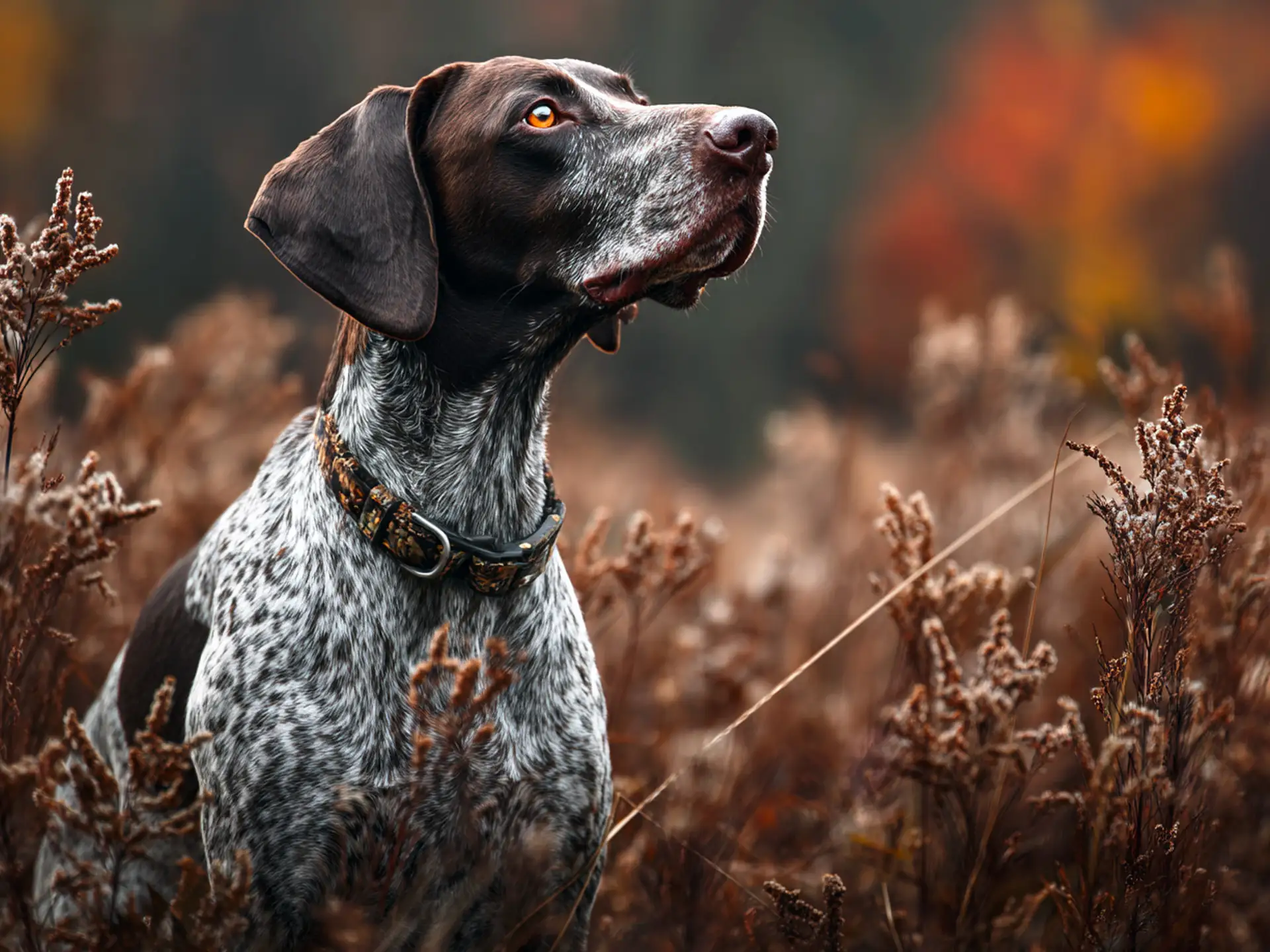
Few dogs embody versatility quite like the German Shorthaired Pointer. Developed in the 19th century, this breed was designed to be the ultimate all-purpose hunting companion. Hunters wanted a dog that could point upland birds with precision, retrieve from both land and water, and track wounded game when needed. The result was a breed that combines intelligence, stamina, and adaptability in one powerful package.
The German Shorthaired Pointer is easily recognized by its sleek, athletic build and eager expression. In the field, it moves with speed and determination, covering ground efficiently while keeping an eye on its handler. Whether you are chasing pheasants across open farmland or retrieving ducks from a marsh, this breed delivers reliable performance in almost any setting.
At home, the German Shorthaired Pointer can be a loving and loyal family member as long as its exercise needs are met. This is a high-energy dog that thrives on daily runs, long hikes, or regular training sessions. When given a job to do and plenty of mental stimulation, it becomes a devoted companion who fits seamlessly into active households.
Key Traits
Best For: Upland birds and versatile hunting
Energy Level: Very high
Training Needs: Responds well to positive reinforcement and consistency
Family Suitability: Excellent choice for active families
2. German Wirehaired Pointer (Deutsch Drahthaar)
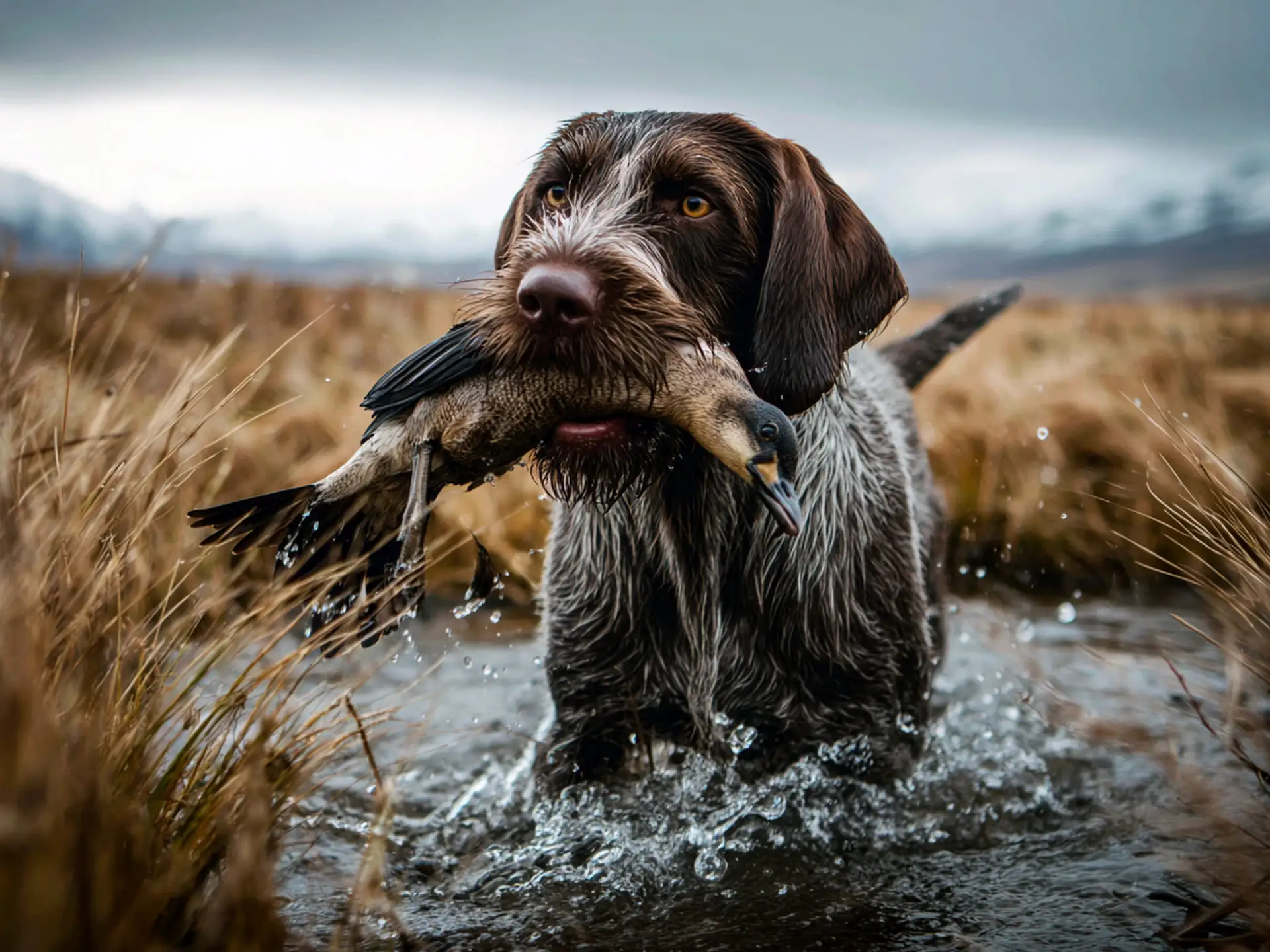
The German Wirehaired Pointer is a rugged, hardworking breed built for hunters who demand versatility and endurance. Originating in Germany in the late 1800s, it was developed by crossing several breeds to create a dog capable of handling birds, waterfowl, and even furred game in challenging terrain and weather conditions.
What makes the German Wirehaired Pointer stand out is its distinctive coat. The dense, wiry hair provides excellent protection from cold, wet environments and thorny underbrush, making this dog a natural fit for hunters who work in rough cover or late-season conditions. Beyond its physical resilience, this breed is known for its determination, intelligence, and strong work ethic.
In the field, the German Wirehaired Pointer is a confident hunter with an exceptional nose and an eagerness to please. It points, retrieves, and tracks with enthusiasm, performing well in both open fields and marshy wetlands. At home, it is loyal and affectionate but needs regular exercise and mental challenges to stay happy and well-behaved. Daily training sessions, hunting trips, or long hikes keep this breed balanced and content.
Key Traits
Best For: Upland birds, waterfowl, and versatile hunting
Energy Level: High
Training Needs: Benefits from consistent, positive training methods
Family Suitability: A good choice for active homes with plenty of outdoor time
3. Weimaraner
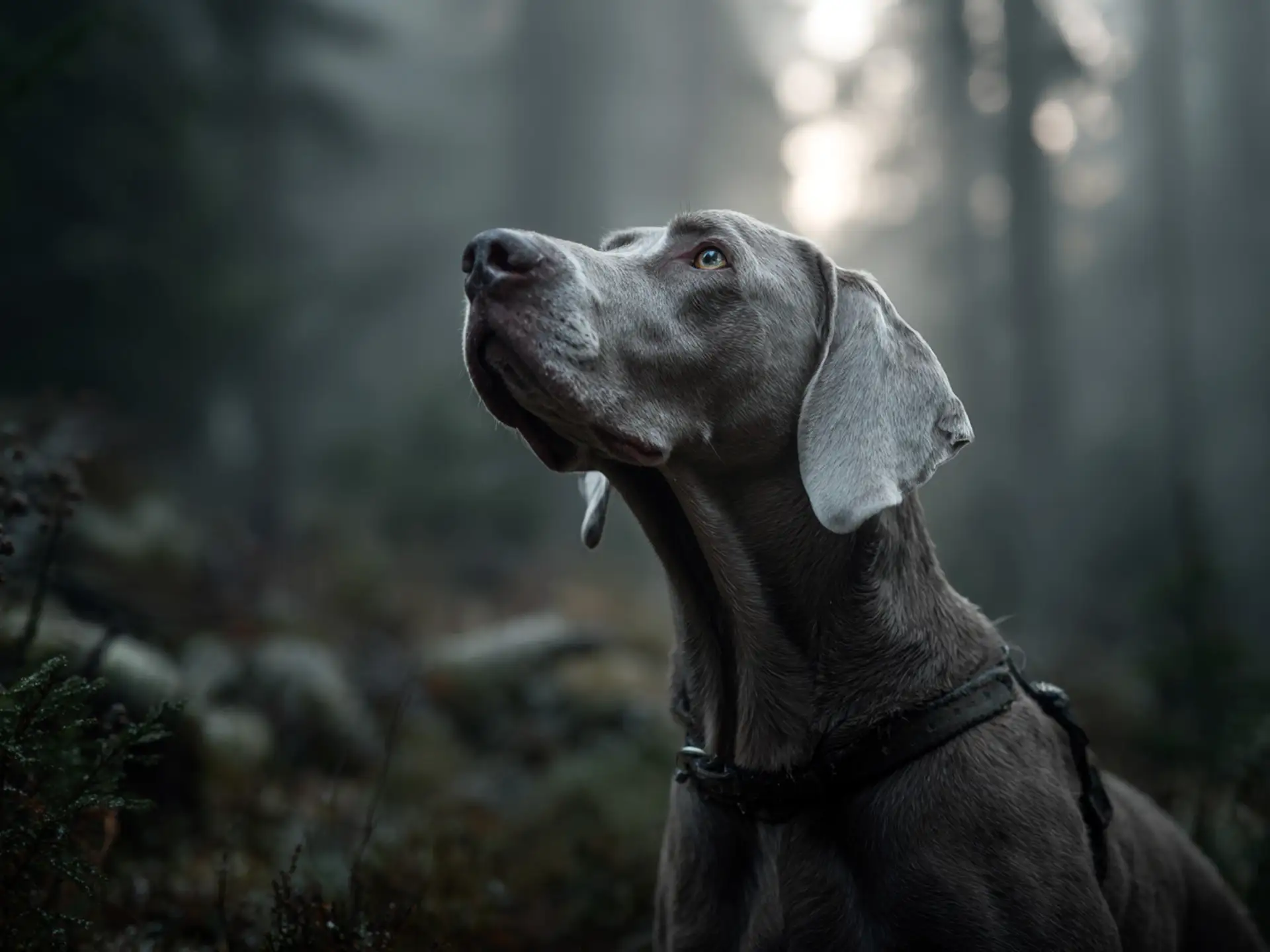
The Weimaraner, often called the “Gray Ghost” for its sleek silver-gray coat, is one of Germany’s most iconic hunting breeds. Originally developed in the early 19th century for big-game hunting, it later became prized for its versatility with upland birds, waterfowl, and even tracking wounded animals.
This breed is athletic, graceful, and known for its tireless energy. In the field, the Weimaraner works with speed and determination, covering large areas with its keen nose and strong prey drive. It excels at pointing and retrieving, making it a favorite for hunters who want a capable all-around partner.
Beyond its hunting abilities, the Weimaraner forms deep bonds with its family. It is affectionate, loyal, and thrives when it can stay close to its people. However, this closeness comes with a need for plenty of activity and mental stimulation. Without daily exercise, training, and interaction, the Weimaraner can become anxious or develop unwanted behaviors.
For hunters with an active lifestyle who want a devoted companion in the field and at home, the Weimaraner offers both skill and loyalty in a striking, athletic package.
Key Traits
Best For: Upland birds, big-game tracking, versatile hunting
Energy Level: Very high
Training Needs: Responds well to positive training and consistency
Family Suitability: Great with active families willing to provide exercise and structure
4. Pudelpointer
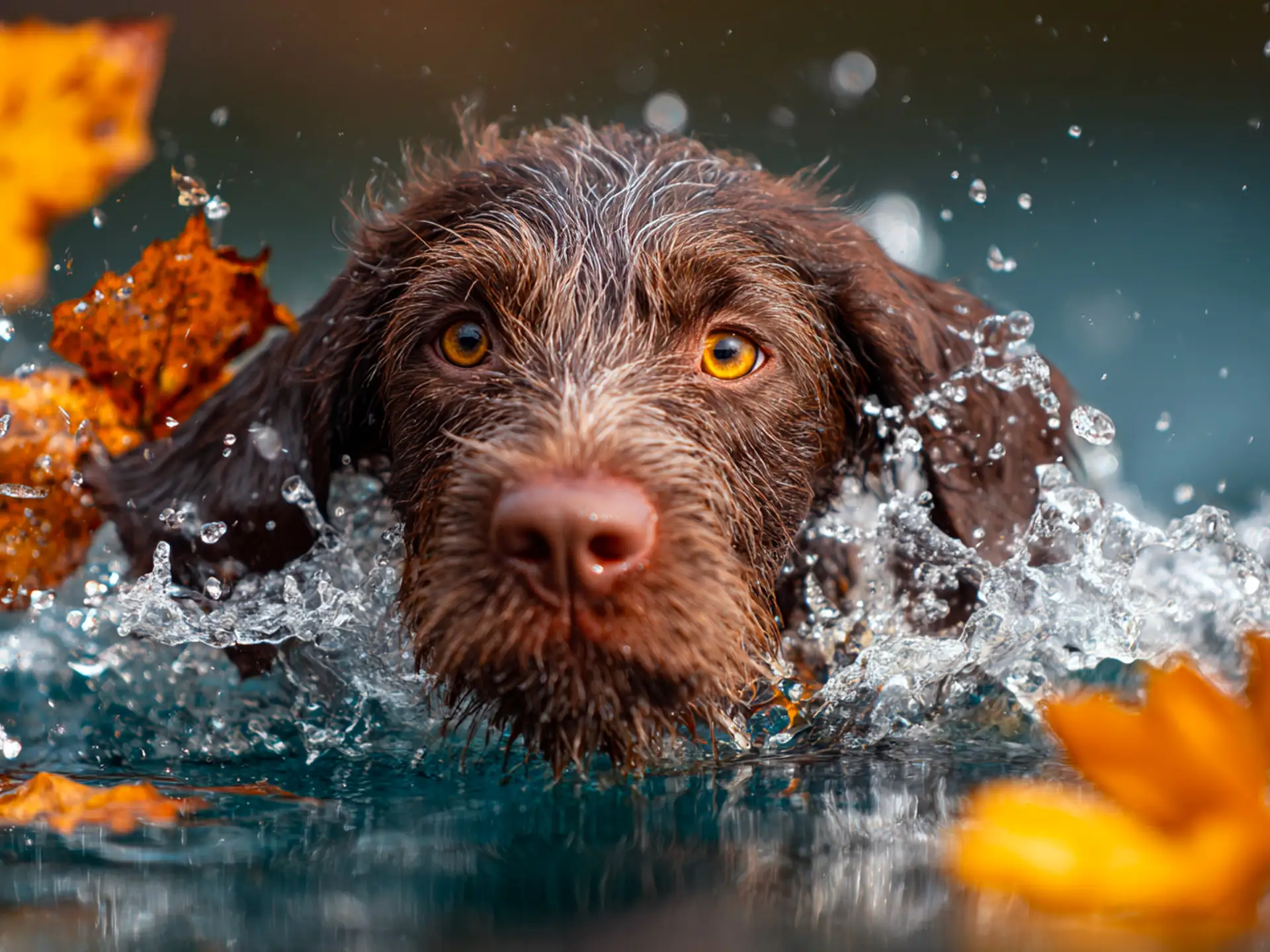
The Pudelpointer is one of Germany’s best-kept secrets in the hunting world. Developed in the late 1800s by crossing the English Pointer with the Poodle, this breed was designed to combine the Pointer’s keen nose and hunting instincts with the Poodle’s intelligence, trainability, and strong swimming ability. The result is a dog equally skilled on land and in water, making it a true all-rounder for hunters who need versatility.
In the field, the Pudelpointer is steady, focused, and cooperative. It points gamebirds with confidence, retrieves from both land and water with enthusiasm, and has the drive to track wounded animals when needed. Hunters appreciate its natural ability and willingness to work closely with its handler, which makes training straightforward even for less experienced owners.
At home, the Pudelpointer is known for its calm and friendly nature. While it needs plenty of exercise and mental stimulation, it tends to be less intense than some of the other high-energy German hunting breeds, making it a good fit for active families as well as dedicated hunters.
Key Traits
Best For: Upland birds, waterfowl, versatile hunting
Energy Level: High
Training Needs: Easy to train with consistent guidance
Family Suitability: Excellent choice for families wanting a balanced hunting companion
5. Small Münsterländer
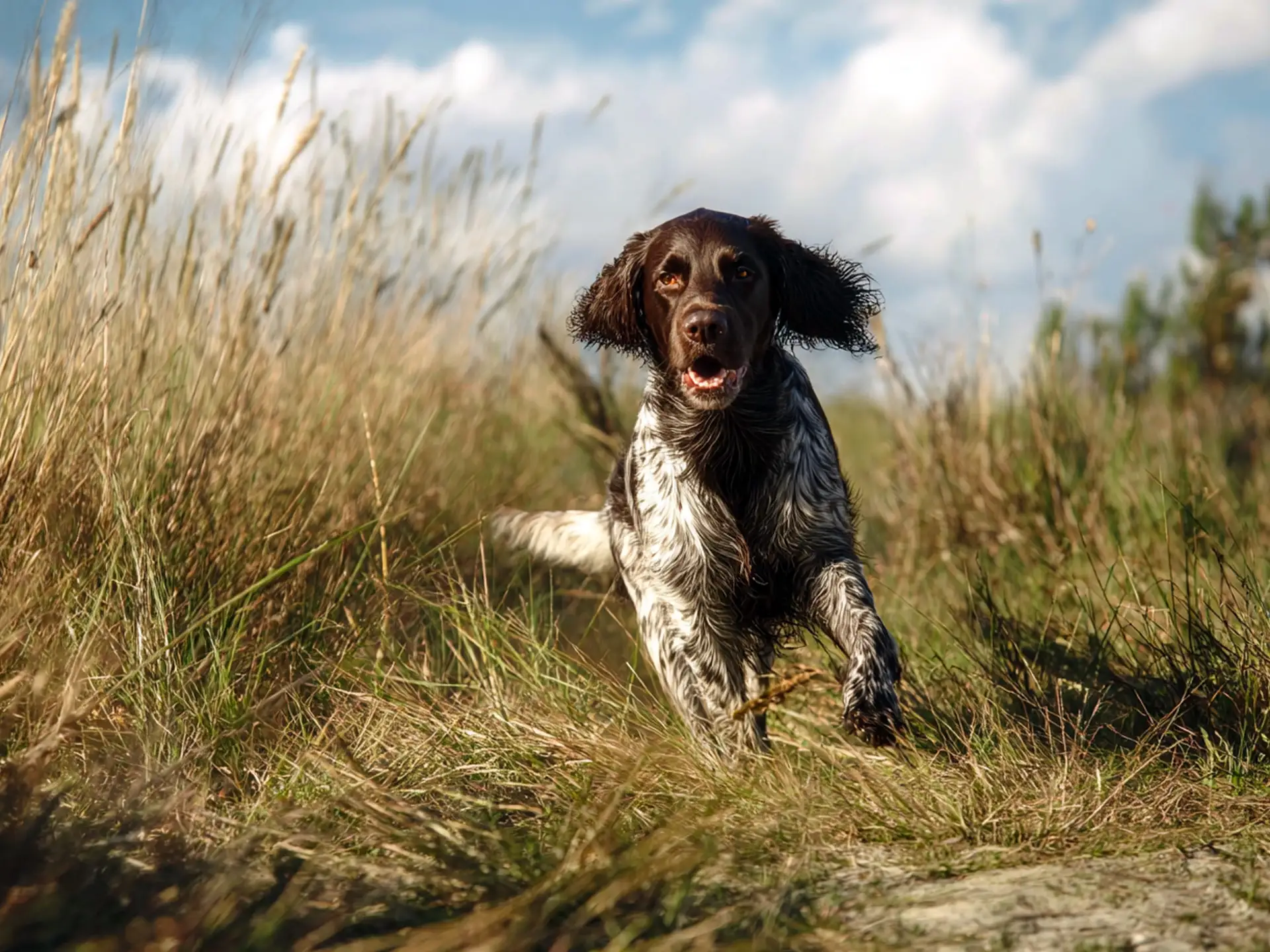
The Small Münsterländer is a compact yet powerful hunting dog that has gained a loyal following among hunters who value cooperation and versatility. Originating in Germany centuries ago, this breed was refined to excel in upland bird hunting, water retrieves, and tracking wounded game. Its size makes it easy to handle, yet it has the stamina and drive to work long days in the field.
Hunters appreciate the Small Münsterländer for its natural pointing ability, strong retrieving instincts, and willingness to stay connected with its handler. It is known for hunting at a moderate range, which makes it a favorite for those who want a close-working partner rather than a dog that runs out of sight. Its keen nose and intelligence help it adapt to different hunting situations with ease.
At home, the Small Münsterländer is affectionate, loyal, and typically good with children. Like all hunting breeds, it needs regular exercise and mental stimulation, but its cooperative nature and balanced temperament make it one of the more family-friendly hunting dogs in the German tradition.
Key Traits
Best For: Upland birds, waterfowl, versatile hunting
Energy Level: High
Training Needs: Eager to learn and responsive to guidance
Family Suitability: Excellent choice for families wanting a close-working hunting partner
6. Large Münsterländer
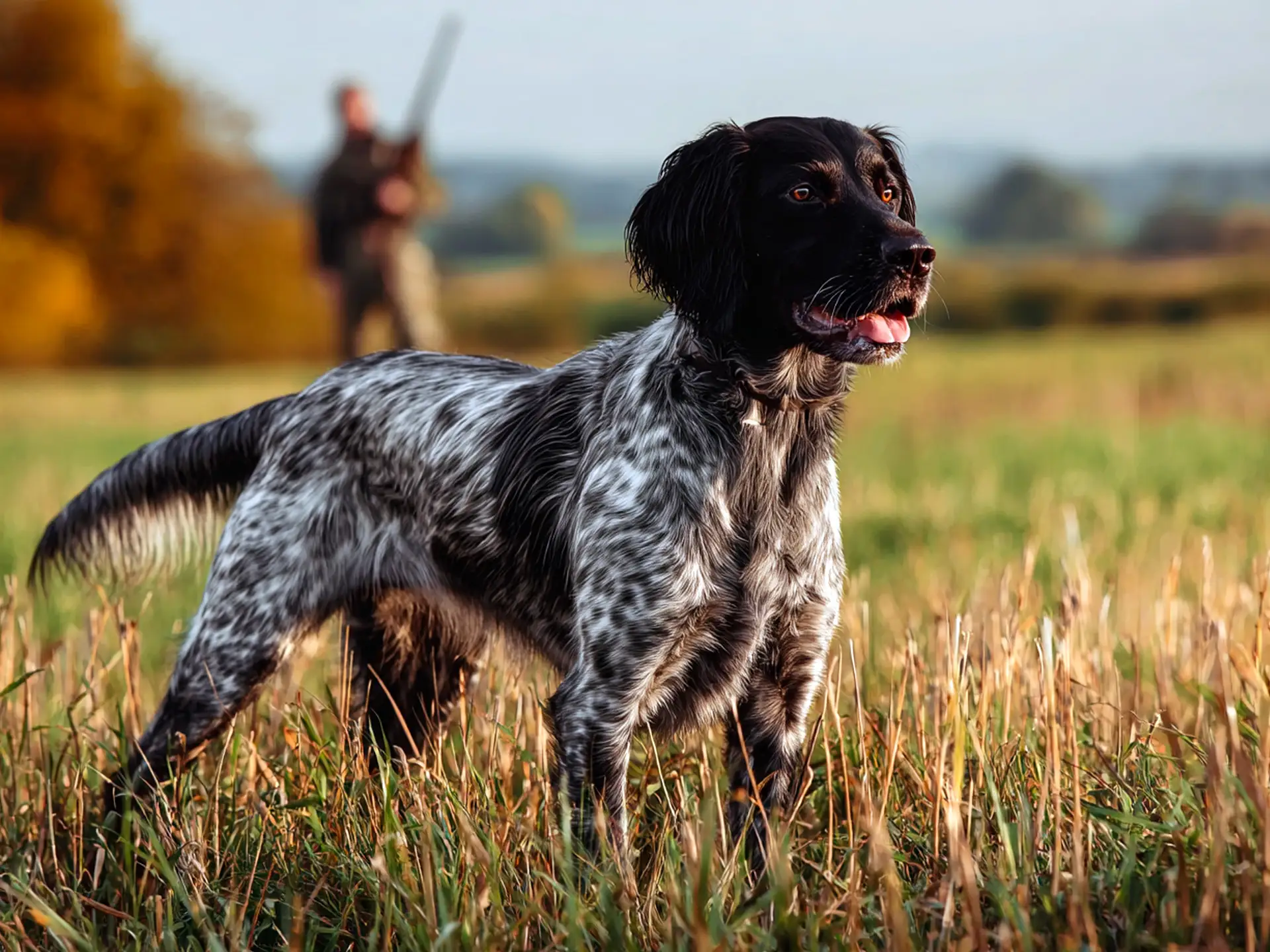
The Large Münsterländer shares much of its history with its smaller cousin but brings a larger frame, slightly more power, and the same cooperative nature that hunters appreciate. Originating in the Münster region of Germany, this breed was developed to handle upland birds, waterfowl, and furred game, making it a true all-purpose hunting dog.
In the field, the Large Münsterländer combines stamina, intelligence, and a strong desire to please its handler. It points game confidently, retrieves on both land and water, and can track wounded animals when the situation calls for it. Its steady temperament and willingness to work closely make it a reliable partner for hunters who want one dog for many tasks.
At home, the Large Münsterländer is friendly and affectionate but needs daily activity to stay happy. Long runs, training exercises, or off-season dog sports help keep this energetic dog balanced. When its physical and mental needs are met, it becomes a loyal family companion as well as a skilled hunting partner.
Key Traits
Best For: Upland birds, waterfowl, versatile hunting
Energy Level: High
Training Needs: Learns quickly with consistent training
Family Suitability: Good for active families who enjoy the outdoors
7. German Longhaired Pointer (Deutsch Langhaar)
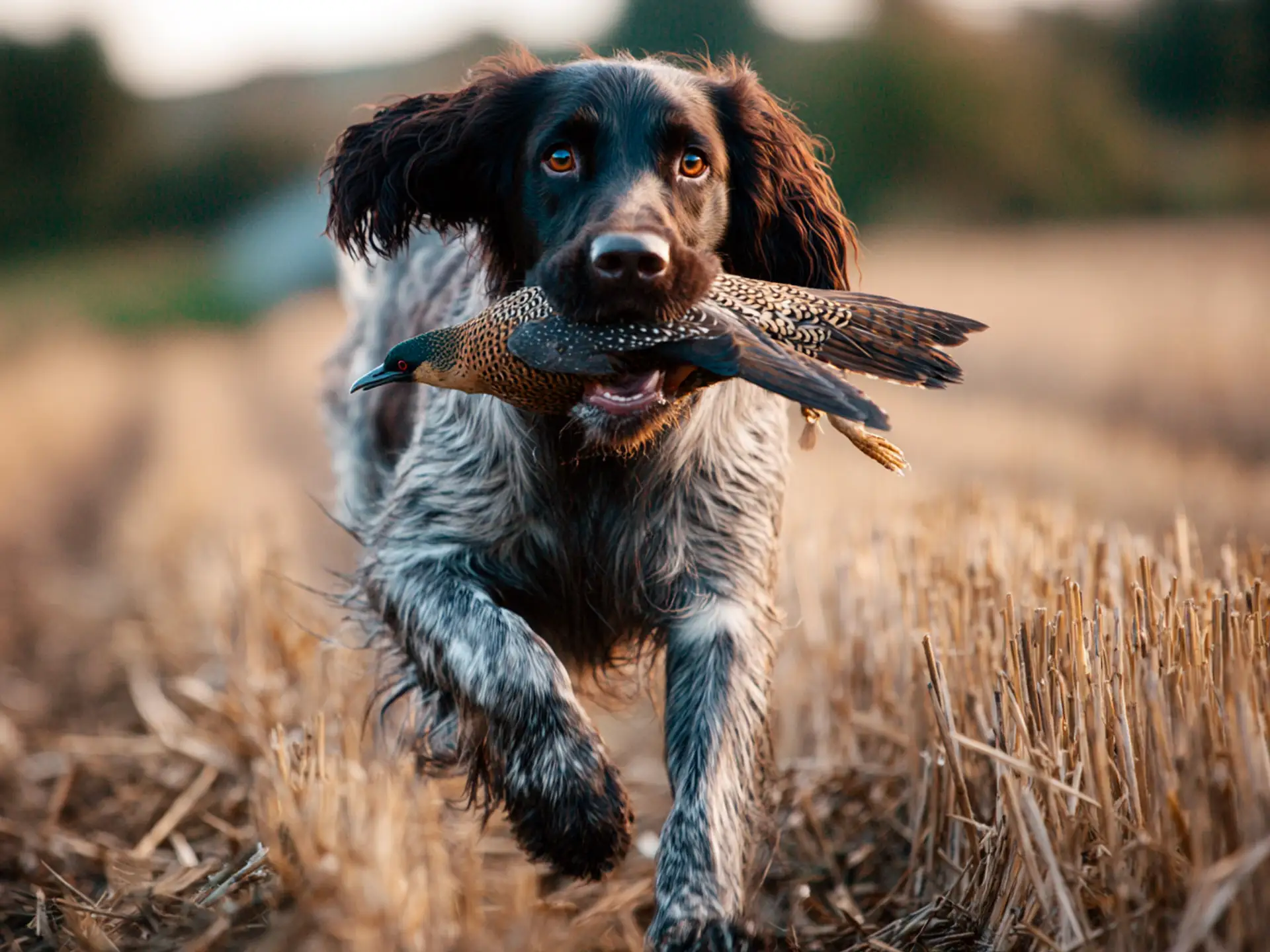
The German Longhaired Pointer is one of the older pointing breeds in Germany, dating back to at least the nineteenth century. It was originally developed as a multipurpose hunting dog that could point gamebirds, retrieve from land and water, and work as a loyal partner for hunters across a variety of terrains. Its flowing coat and elegant build give it a striking appearance, but beneath the beauty is a serious working dog.
In the field, the German Longhaired Pointer is known for its calm, steady style and its strong sense of cooperation with its handler. It excels in upland bird hunting and water retrieves, and like many German breeds, it can track wounded game when needed. Its combination of athletic ability and willingness to learn makes it a versatile choice for hunters who value a close-working dog.
At home, this breed can be affectionate and gentle with families, though it does need plenty of exercise to stay happy. Regular training sessions, hunting trips, or active playtime will keep it physically fit and mentally stimulated. With the right balance of work and family interaction, the German Longhaired Pointer can thrive as both a hunting companion and a loyal household member.
Key Traits
Best For: Upland birds, waterfowl, versatile hunting
Energy Level: High
Training Needs: Responds well to patient, consistent training
Family Suitability: Good with families that enjoy an active lifestyle
8. Bavarian Mountain Hound
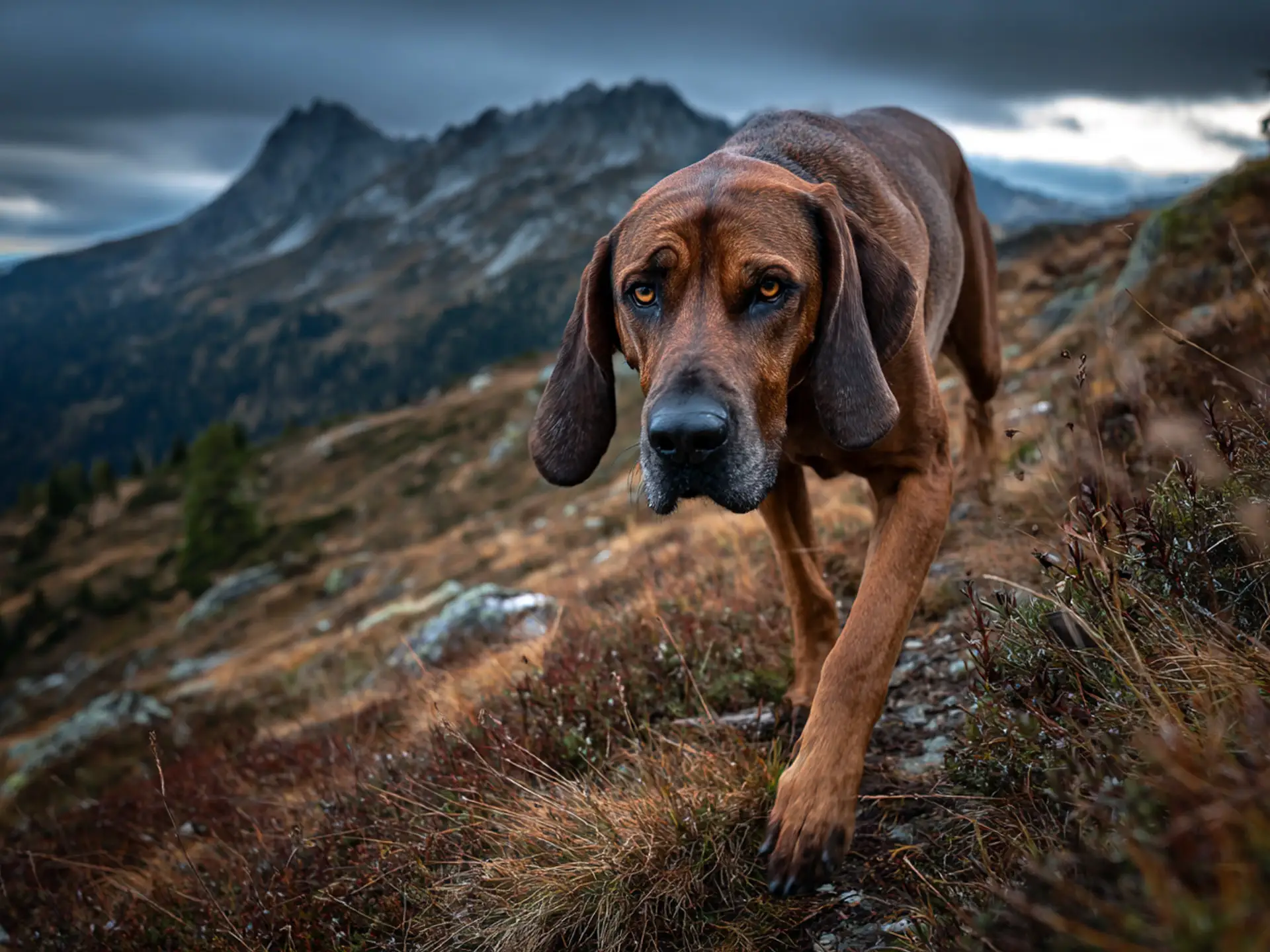
The Bavarian Mountain Hound is a specialist breed developed in Germany for one primary purpose: tracking wounded big game through rugged, mountainous terrain. Hunters needed a dog with an exceptional nose, a calm and methodical approach, and the stamina to follow difficult trails for hours if necessary. The Bavarian Mountain Hound delivers all of this in a medium-sized, athletic package.
Unlike versatile pointing breeds, this hound works close to its handler, moving with focus and determination rather than covering ground at high speed. It is valued for its ability to stay on a cold trail even when scent conditions are challenging, which makes it a trusted partner for ethical hunting and recovery efforts.
At home, the Bavarian Mountain Hound is typically calm and devoted but does best in households that can meet its need for regular outdoor activity. A securely fenced yard, long walks, and opportunities to use its nose help keep this intelligent breed happy and well-adjusted.
Key Traits
Best For: Big-game tracking and recovery work
Energy Level: Moderate
Training Needs: Benefits from early obedience and tracking training
Family Suitability: Good with families that enjoy the outdoors and have space
9. Hanoverian Scenthound
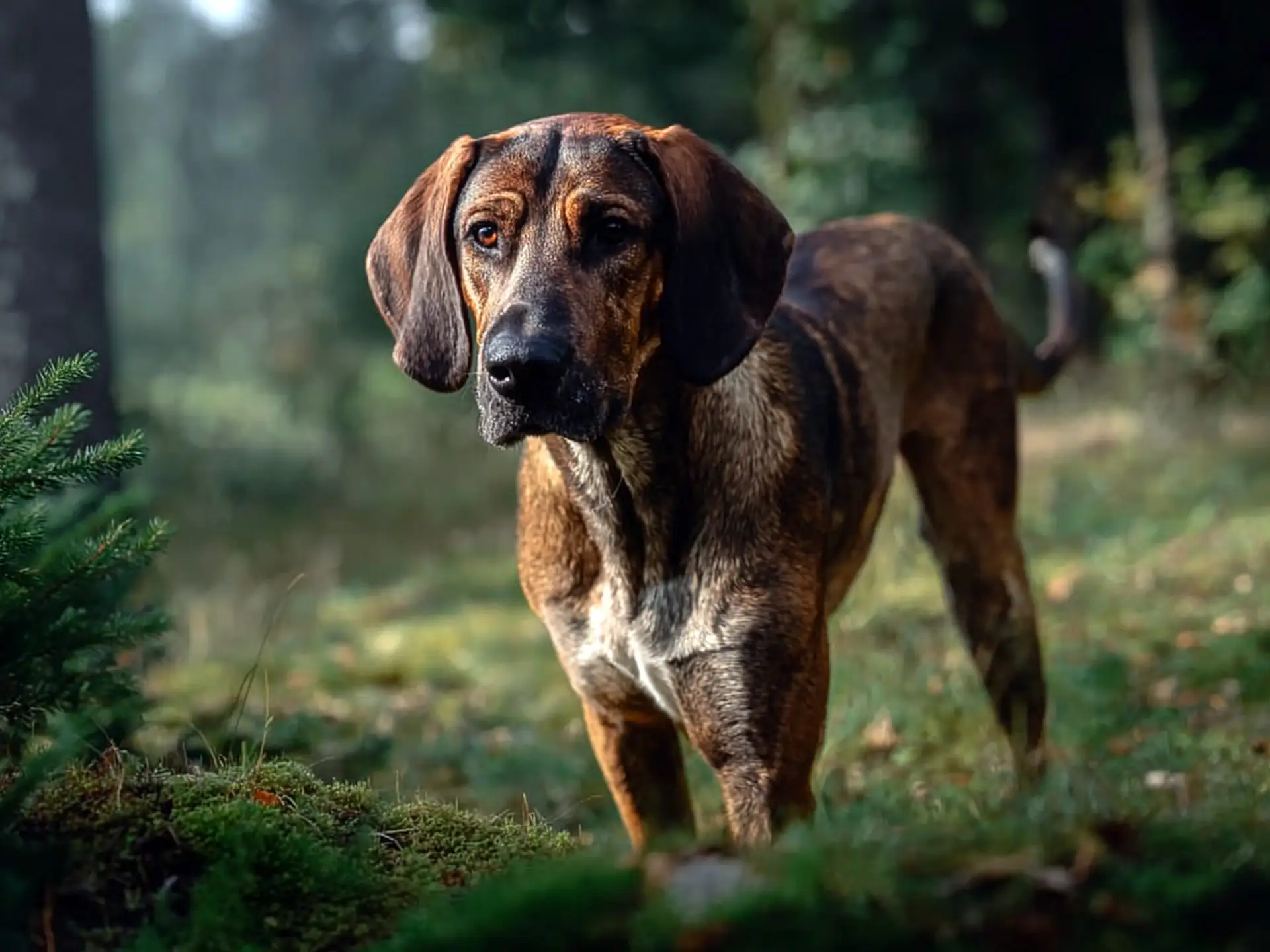
The Hanoverian Scenthound is one of Germany’s oldest and most respected tracking breeds. Developed in the Hanover region, it was bred specifically for following the scent of wounded game over long distances and challenging terrain. Its powerful nose and steady, deliberate approach make it a favorite among hunters who need a reliable partner for recovery work.
This breed works at a measured pace rather than racing ahead, carefully following scent particles that may be hours or even days old. The Hanoverian Scenthound is calm and focused in the field, showing persistence and accuracy that make it invaluable for ethical hunting practices.
At home, it is loyal and affectionate with its family but benefits most from a home where it can get regular exercise and opportunities to use its tracking instincts. While not as high-energy as some of the pointing breeds, it still needs outdoor activities and mental stimulation to stay balanced and happy.
Key Traits
Best For: Big-game tracking and recovery work
Energy Level: Moderate
Training Needs: Responds well to consistent tracking and obedience training
Family Suitability: Good for families with space and an active lifestyle
10. Deutsche Bracke (German Hound)
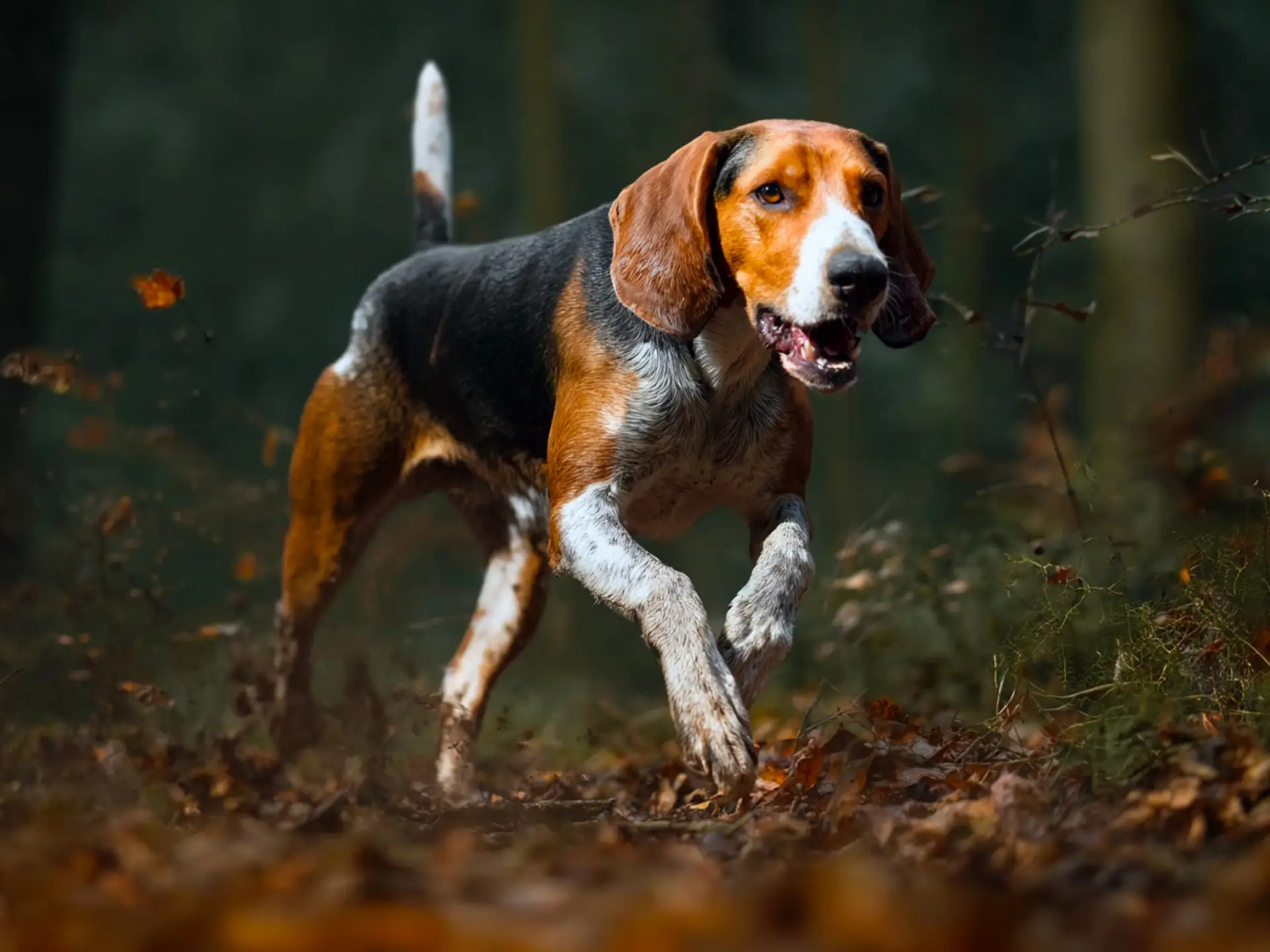
The Deutsche Bracke, also known simply as the German Hound, is one of Germany’s traditional scenthounds. Developed for hunting in dense forests and hilly terrain, this breed is known for its excellent nose, stamina, and distinctive musical voice that hunters can hear as it follows a trail.
Unlike versatile pointing breeds, the Deutsche Bracke specializes in tracking and driving game toward hunters. It works methodically and reliably, often in challenging weather and landscape conditions, making it a valuable partner for hunters who focus on tracking or want a dog with a strong work ethic and determination.
At home, the Deutsche Bracke is typically friendly and loyal but does best with owners who can provide plenty of outdoor activity and structure. It thrives in rural or suburban environments where it can safely exercise and use its nose regularly.
Key Traits
Best For: Scent tracking and driving game in wooded terrain
Energy Level: High
Training Needs: Benefits from early obedience and tracking training
Family Suitability: Good for active families with space and outdoor time
11. German Spaniel (Deutscher Wachtelhund)
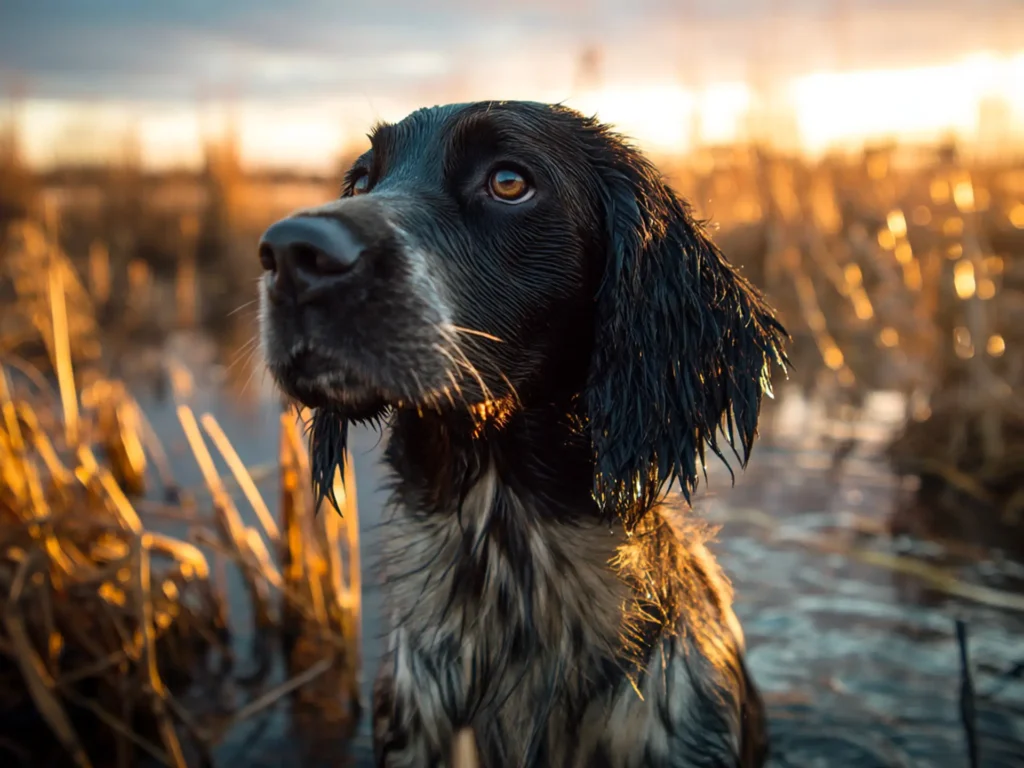
The German Spaniel, known in its homeland as the Deutscher Wachtelhund, is a versatile hunting dog developed for flushing and retrieving game in challenging conditions. Bred primarily in the early twentieth century, it quickly became a favorite among hunters who needed a dog that could work close to the gun, handle dense cover, and adapt to multiple types of game.
In the field, the German Spaniel is energetic, determined, and eager to please. It specializes in driving game out of thick cover for hunters, retrieving downed birds, and performing well in both upland and waterfowl settings. Its dense, weather-resistant coat allows it to work in harsh climates and challenging terrain without hesitation.
At home, the German Spaniel is affectionate and loyal, often forming strong bonds with its family. Like most hunting breeds, it needs regular exercise, mental stimulation, and training to stay happy and well-behaved. When its needs are met, it can be both a capable hunting companion and a pleasant family dog.
Key Traits
Best For: Flushing, retrieving, upland birds, waterfowl
Energy Level: High
Training Needs: Learns quickly with positive reinforcement
Family Suitability: Excellent choice for active families who enjoy the outdoors
12. Jagdterrier (German Hunting Terrier)
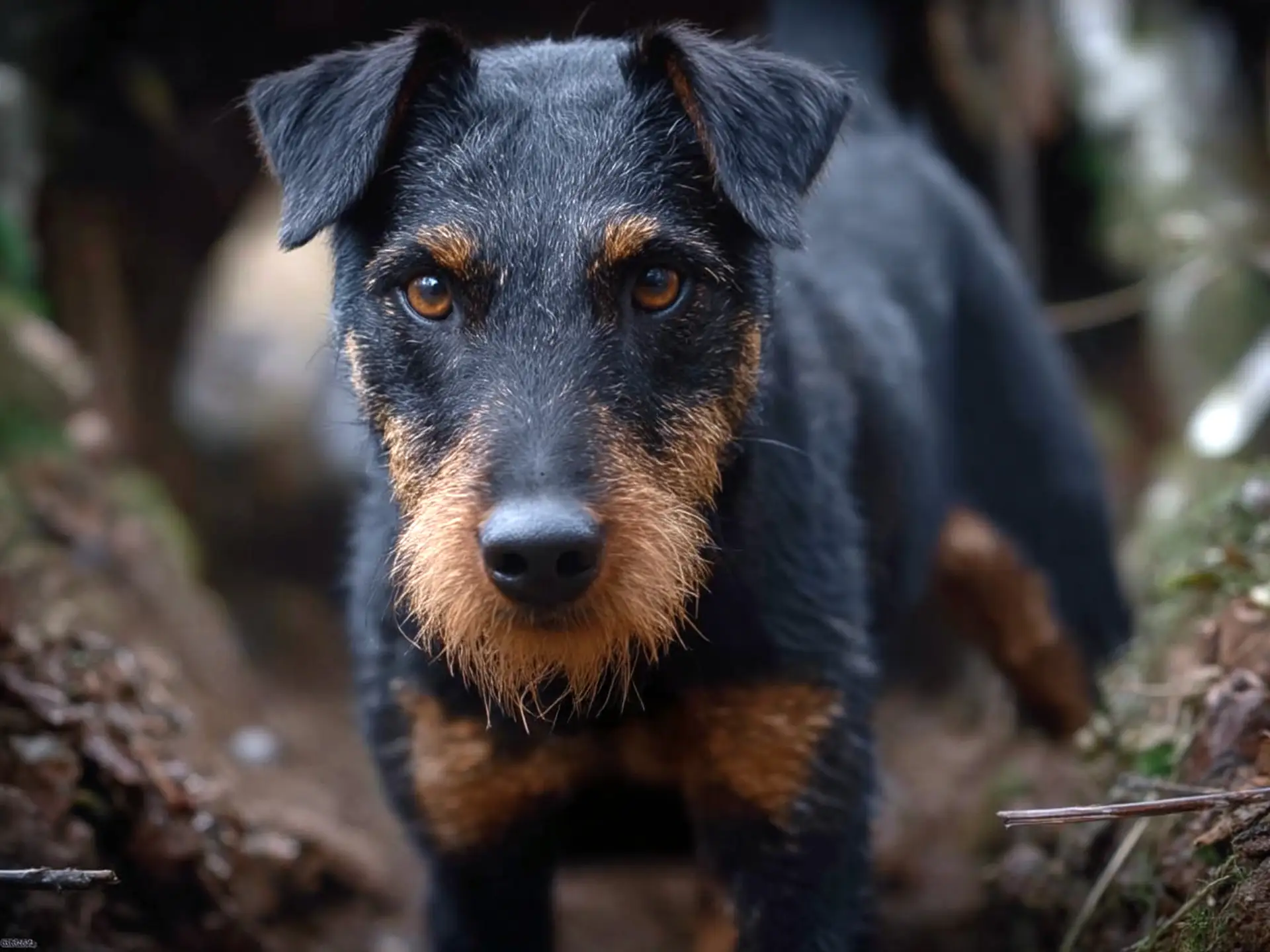
The Jagdterrier, or German Hunting Terrier, is a small but incredibly determined working dog developed in the early twentieth century for serious hunters. Despite its compact size, the Jagdterrier has a fearless personality and an impressive drive that makes it ideal for specialized tasks such as flushing game, tracking wounded animals, and even working underground to pursue quarry like foxes or badgers.
What sets this breed apart is its courage and tenacity. The Jagdterrier works tirelessly in the field, moving with confidence and determination regardless of terrain or weather. It is well-known for its versatility, able to handle different types of game and hunting situations while remaining focused and cooperative with its handler.
At home, the Jagdterrier is loyal and affectionate with its family but needs plenty of activity and mental stimulation to stay happy. This is not a breed for casual pet owners or those with limited time for training and exercise. Experienced handlers who can channel its drive will find a hardworking and devoted companion both in the field and at home.
Key Traits
Best For: Flushing game, tracking, underground hunting work
Energy Level: Very high
Training Needs: Requires consistent and structured training
Family Suitability: Best suited for experienced and active hunting households
How to Choose the Right German Hunting Dog
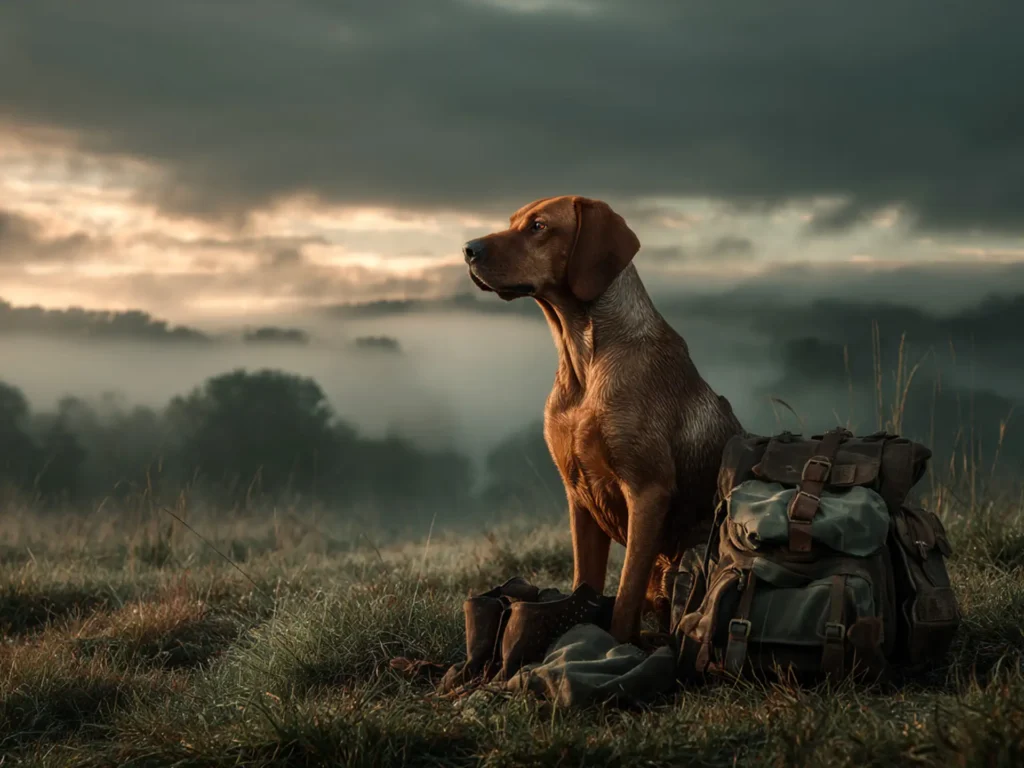
With so many outstanding German hunting dog breeds to choose from, the best fit for you depends on three main factors: your hunting style, your living environment, and your experience as a handler. Taking time to match the right breed to your needs will ensure both you and your dog have a rewarding partnership in the field and at home.
Hunting Style:
If you hunt upland birds like pheasants or quail, pointing breeds such as the German Shorthaired Pointer, Small Münsterländer, or Weimaraner will likely be the best choice. For hunters who want a versatile dog capable of both pointing and retrieving waterfowl, the Pudelpointer or German Wirehaired Pointer are excellent options. If big-game tracking is your focus, breeds like the Bavarian Mountain Hound or Hanoverian Scenthound offer unmatched skill for following wounded animals.
Living Environment:
High-energy breeds like the German Shorthaired Pointer or Weimaraner thrive in homes with plenty of outdoor space and active families. If you live in a suburban setting but can commit to daily training and exercise, moderate-energy breeds such as the German Spaniel or Small Münsterländer can also adapt well as long as they stay physically and mentally engaged.
Experience Level:
First-time hunting dog owners may prefer breeds with an easier temperament and cooperative nature, such as the Pudelpointer or Small Münsterländer. More intense or independent breeds like the Jagdterrier or Hanoverian Scenthound may be better suited for experienced handlers who understand how to channel a strong prey drive and high energy into productive work.
By weighing these factors carefully, you can choose a German hunting dog breed that fits your hunting goals, home life, and personal experience level, ensuring a happy and successful partnership.
Training and Care Tips for German Hunting Dogs
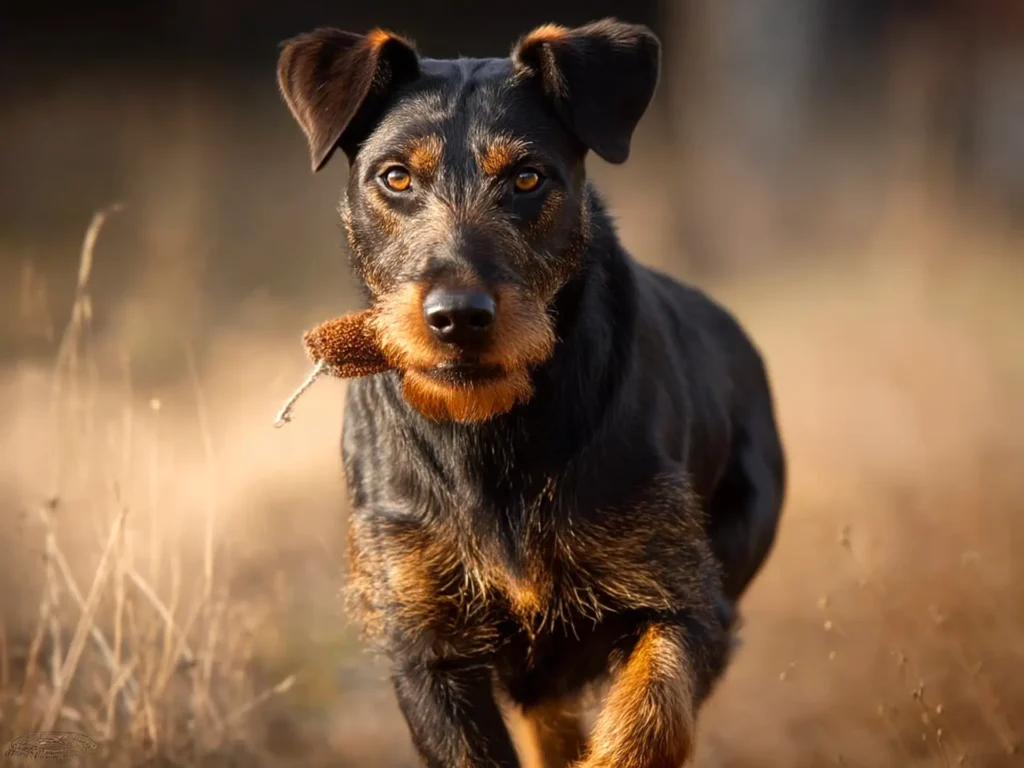
Owning a German hunting dog means welcoming an energetic, intelligent partner into your life. These breeds thrive on structure, activity, and interaction, so giving them the right training and care will keep them happy, healthy, and ready for the hunt.
Start Training Early
Begin obedience and socialization as soon as you bring your puppy home. Early exposure to people, other animals, and different environments builds confidence and prevents behavioral issues later. Hunting-specific training can start gradually, using positive reinforcement to teach basic commands before moving on to fieldwork like retrieving or pointing.
Provide Plenty of Exercise
Most German hunting breeds have high energy levels and need daily activity to stay balanced. Long walks, runs, swimming sessions, or off-season dog sports such as agility or scent work keep them physically fit and mentally sharp. A tired dog is a happy dog, and regular exercise also strengthens the bond between you and your hunting companion.
Keep Their Minds Active
Mental stimulation is just as important as physical exercise. Puzzle toys, obedience drills, or even hide-and-seek games with treats help prevent boredom, which can lead to destructive behaviors in intelligent working breeds.
Health and Grooming
Routine veterinary checkups, a balanced diet, and preventive care like vaccinations and parasite control keep your dog healthy for the long haul. Grooming needs vary by breed; for example, German Wirehaired Pointers require regular coat care, while short-haired breeds like the Weimaraner are lower maintenance.
Off-Season Activities
Don’t let your dog’s skills go rusty when hunting season ends. Off-season training, scent tracking exercises, and obedience refreshers maintain sharpness and strengthen the human-dog partnership year-round.
Frequently Asked Questions About German Hunting Dog Breeds
What is the most versatile German hunting dog?
The Pudelpointer and Small Münsterländer are often recommended for beginners. Both breeds are cooperative, versatile, and easier to train than some high-drive breeds. They adapt well to family life while still offering the hunting instincts and skills needed for upland birds and waterfowl.
Are German hunting dogs good family pets?
Many German hunting breeds, such as the German Shorthaired Pointer and German Spaniel, can be excellent family companions if their exercise and training needs are met. They are loyal, affectionate, and intelligent, making them great partners for active households that enjoy outdoor activities.
What is the difference between the Deutsch Drahthaar and the German Wirehaired Pointer?
The Deutsch Drahthaar is bred in Germany under strict performance and health testing standards, while the German Wirehaired Pointer in North America has more varied breeding programs. Both look similar and have versatile hunting skills, but the German system focuses heavily on consistent working ability.
Which German hunting dog is best for big-game tracking?
The Bavarian Mountain Hound and the Hanoverian Scenthound are both specialists in tracking wounded big game. They have exceptional noses, steady temperaments, and the persistence needed to follow difficult trails, making them the top choices for ethical hunters who prioritize recovery work.
How much exercise do German hunting dogs need daily?
Most German hunting breeds need at least one to two hours of physical activity every day, along with mental stimulation through training or scent work. Without enough exercise, they may develop boredom-related behaviors, so active families or hunters are the best match for these dogs.
Conclusion
German hunting dog breeds have earned their reputation through centuries of careful breeding, rigorous testing, and real-world performance. From versatile pointers like the German Shorthaired Pointer to dedicated trackers like the Bavarian Mountain Hound, each breed brings unique strengths to the field and the family home.
The best choice depends on your hunting style, living situation, and experience level. Active families who enjoy hiking and outdoor sports may love the cooperative nature of the Pudelpointer or Small Münsterländer, while seasoned hunters seeking a big-game specialist might prefer the Hanoverian Scenthound or Bavarian Mountain Hound.
No matter which breed you choose, regular training, exercise, and mental stimulation will ensure your dog stays healthy, happy, and ready for every adventure. With the right care and partnership, a German hunting dog can be more than just a working companion — it can become a loyal member of the family and a trusted partner in the field.

